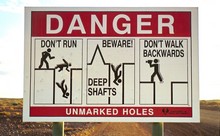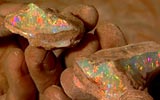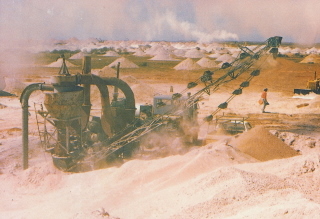Coober Pedy
‘Kupa Piti’ is an Aboriginal name meaning ‘White Man in a Hole’ in the language of the Kokatha people the traditional owners of the area. It was selected from four proposed names by a newly formed progress committee in June 1920.
‘Coober’, as it is affectionately referred to, by its 4000 inhabitants, is also known as the ‘Opal Capital of the World’.
The Coober Pedy Opal fields contain the largest concentration of opal bearing ground in the world. Known for yielding big ‘runs’or patches of full colour ‘seam’ Opal, Coober Pedy has been the single greatest producer by quantity over the last century and was instrumental in making Light Opal (milky,white,grey & crystal) the platform of the Opal industry, in terms of market availability and recognition.
 |
 |
 Discovered in 1914 by Willie Hutchison the youngest member of a gold prospecting party which was desperately looking for water at the time. The 14 year old had disobeyed orders and strayed from camp to search for water in the surrounding foothills. When he finally returned after dark, although exhausted he wore a huge grin on his face and his eyes were brightly lit. Willie had not only located a waterhole, he also had a sugar bag full of Opal to show his much relieved father and crew.
Discovered in 1914 by Willie Hutchison the youngest member of a gold prospecting party which was desperately looking for water at the time. The 14 year old had disobeyed orders and strayed from camp to search for water in the surrounding foothills. When he finally returned after dark, although exhausted he wore a huge grin on his face and his eyes were brightly lit. Willie had not only located a waterhole, he also had a sugar bag full of Opal to show his much relieved father and crew.
 |
 |
| Blower & Elevator extracts dirt from underground | Willie Hutchison |
Coober Pedy suffered during the Depression years when opal prices bottomed out. The discovery of the Eight Mile field in 1945 by Toddy Bryant, an Aboriginal woman, caused a great sensation. Her discovery of Opal within 20 centimetres of the surface was a turning point in the history of the field and went a long way towards establishing Coober Pedy’s future prosperity. – Len Cram
The desert landscape around Coober Pedy is extremely barren and the climate dry and unforgiving, 45C in summer and as cool as 4C in winter. The mesas and mogul hills are not only prospective for Opal they have provided low cost, temperate dugout living since the ‘diggers’ returned from the trenches of France in 1918. The exceptional stability of the region’s ancient sandstones makes tunnelling and the excavation of safe and adequate underground homes highly practicable. The temperature in most dugouts only varies about 5C all year round with temperatures inside being from 21C to 26C.
Not surprisingly the majority of Coober Pedy’s population lives underground. This multicultural melting pot consists of 45 nationalities, Greeks, Yugoslavs and Italians predominantly. One could speak Greek throughout their stay here, the Australian accent is the exception and the choice of food is fantastic. Garlic Prawns at Tom & Mary’s are a must!
Interesting attractions in Coober Pedy include the mines, the underground churches, the local golf course which is completely free of grass and the ‘Breakaways’ which resemble a mini Grand Canyon.
Underground at Umoona Mine & Museum  |
The  Postman’s Place Postman’s Place |
Major working areas and famous mines include: German Gully, Black Flag and Benitos Folly South-East of town, Olympic and Southern Cross to the West-South-West. Zorba, Larkins Folly, Hellenic Hill and Russos Folly (15km) East of town. Hans Peak, 8 Mile, 10 Mile, Greek Gully, 14 Mile, 17 Mile and Shell Patch (35km) moving North-West of town in that order.
Map of the Coober Pedy Opal Fields |
| Sources & Image Credits:
ABSALOM’S OUTBACK, John Mabey, 1981. (Andamooka) Andamooka Opal, Peter Taubers (photo of rough crystal opal) BEAUTIFUL OPALS – AUSTRALIAS NATIONAL GEM – SPECIAL 2000 COMMEMORATIVE EDITION, Len Cram, 1999. COOBER PEDY, 65 YEARS YOUNG 1915-1980, Kerry E. Medway, 1981. DIGGING AROUND COOBER PEDY, Anne Johnson, 2006. Mineshaft, Peter Blythe, Mintabie miner & historian Oldtimersmine, An award winning tourist mine dating back to 1916 Opaline, Photo collection Umoona Mine & Opal Museum, (colour photo of dugout interior) |